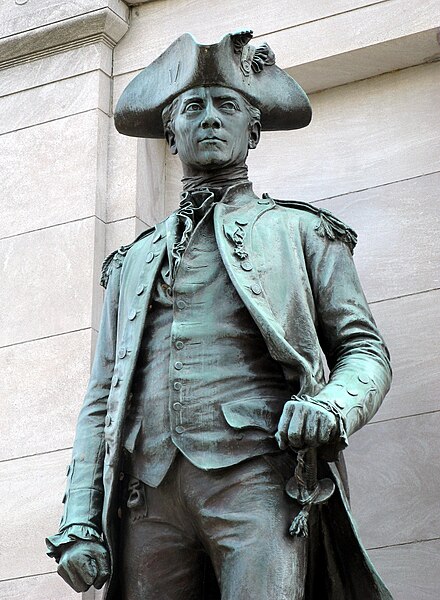John Paul Jones was a famous naval officer who commanded the fledgling Continental Navy during the American Revolution and is regarded as the Father of the United States Navy. Jones is an interesting man and ballsy as all hell. During the war, he lead raids not only against English shipping, but two raids of British Isles themselves - first at
Whitehaven, where he planned to burn all the ships in the harbor and anything else he could, followed by a raid against an Earl's estate on St. Mary's Isle, where he planned to kidnap and hold the Earl for ransom! Like I said, this guy was ballsy. He also participated in an attempted invasion of England by a combined Spanish and French force in 1779 and with several French ships under his nominal command, attempted to create a diversion to lure the Royal Navy's Channel Fleet away. The invasion failed, but in the subsequent battle between his ship, the
Bon Homme Richard and the HMS
Serapis, the legend of his famously proclaiming "I have not yet begun to fight!" was created. There is some doubt as to his saying that, but he did say "I may sink, but I'll be damned if I strike" in response to the captain of the
Serapis asking for his surrender.
Did I mention that at the time, Jone's ship was sinking? And just to top it off, he won that battle and took the
Serapis as his own. After the war, he decided to stay in Europe, first living in Paris, then moving to Russia and taking a job in their navy. He eventually left after political backstabbing a smear campaign directed against him by jealous Russian officers and returned to Paris, where he died on July 18, 1792. He was buried at St. Louis Cemetary, which belonged to the Royal Family of France. Unfortunately, the French Revolution hit not long after, the Revolutionary government that took over sold the land and I guess in the chaos, the everybody forgot "oh hey, there are bodies buried here, somebody might want to note that."
Something worth noting, however, is that when Jones died, a wealthy French admirer of his donated money to have his body preserved in alcohol and buried in a lead coffin, so that way the Americans could better identify him if they decided to reclaim his body at a later point. There was one attempt in 1845 by a Colonel named John Sherburne and this attempt was supported by at least the Navy, but ultimately fell through in 1851 when some of Jones' relatives from Scotland objected to his disinterment. Of course, the main obstacle in reclaiming his body wasn't his relatives, but the fact that nobody knew where he was buried.
Thanks to the efforts of Horace Porter, hero of the Civil War and Ambassador to France, John Paul Jones body was successfully found. He began his search in 1899 and several years later in 1905, lead a team that located the former cemetery and three lead coffins. The first two were a bust, but the third time's a charm and they unearthed the naval war hero. Now here's where things get touching, Jones body could easily have been shipped back to the States on any freighter, but President Theodore Roosevelt sent four cruisers instead, one to carry the coffin and the other three as escorts. When the squadron made it home, they were met by seven battleships that escorted them up the Chesapeake Bay to the Naval Academy at Annapolis, Maryland. That shows the kind of admiration the Navy still held for Jones, that they were willing to reallocate ten ships for one man who died 113 years prior.
Initially, his coffin was placed in Bancroft Hall of the Academy, after a big ceremony that included a eulogy by Roosevelt. In 1913, his body was moved to the crypt of the Naval Academy's Chapel and re-interred in a big marble and bronze sarcophagus and as a lasting tribute to his importance as Father of the Navy, an honor guard of Marines stand guard when the crypt open to the public, which is every day.
Sources:
USNA Traditions,
Wikipedia,
U.S. Navy website.



No comments:
Post a Comment